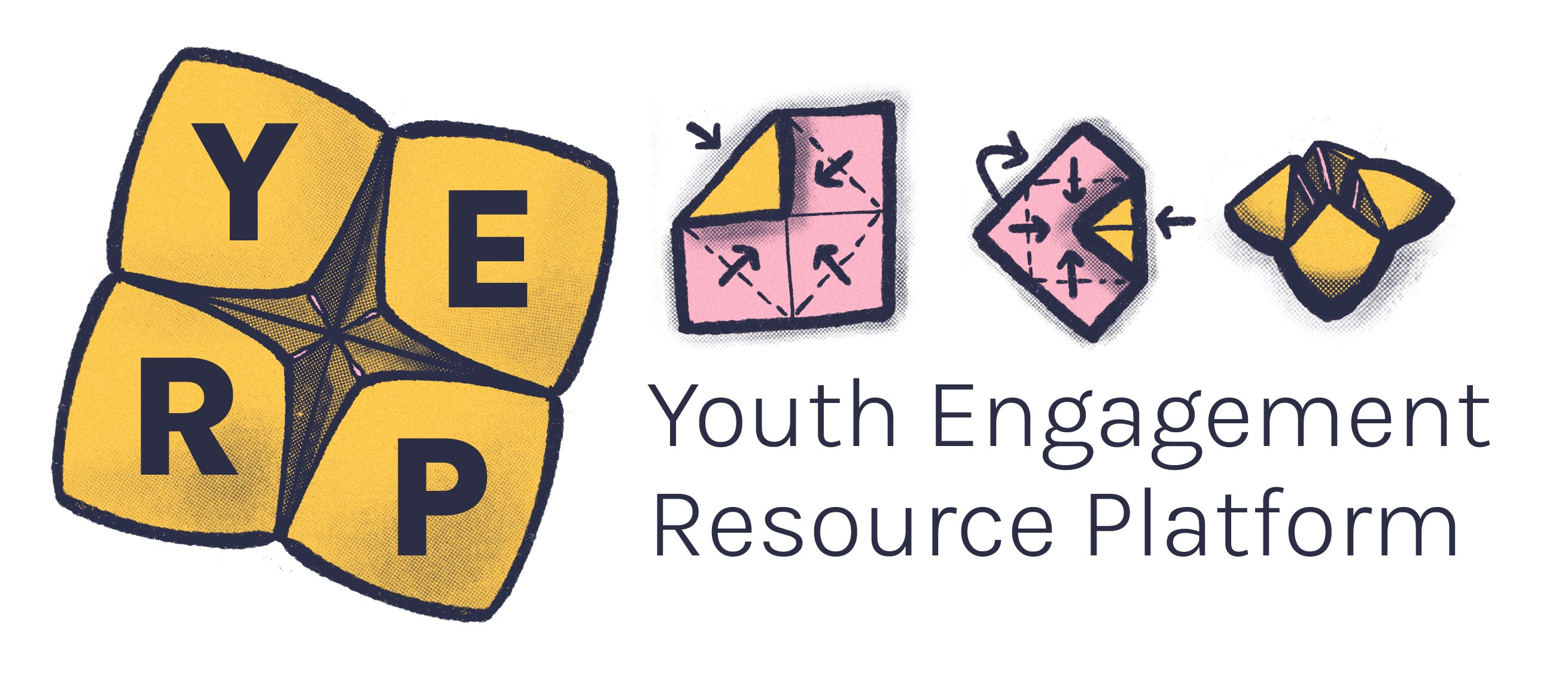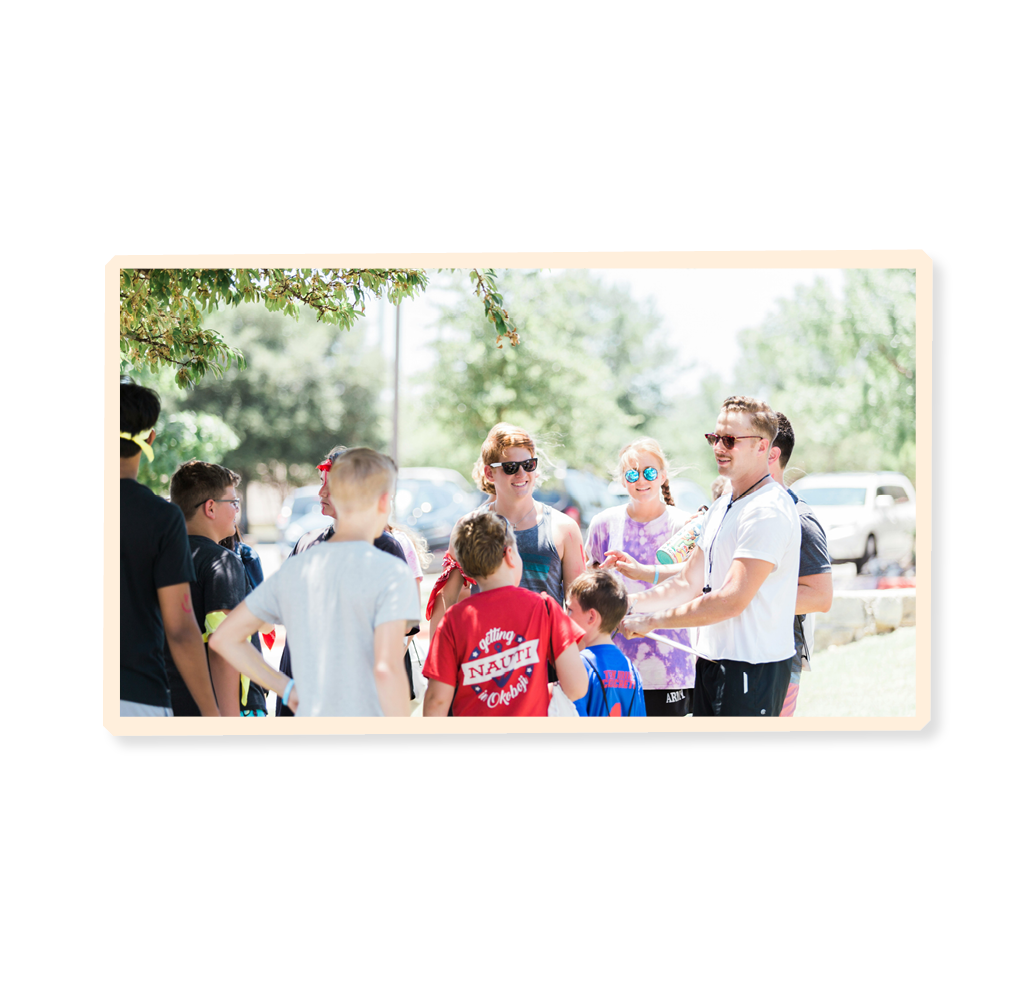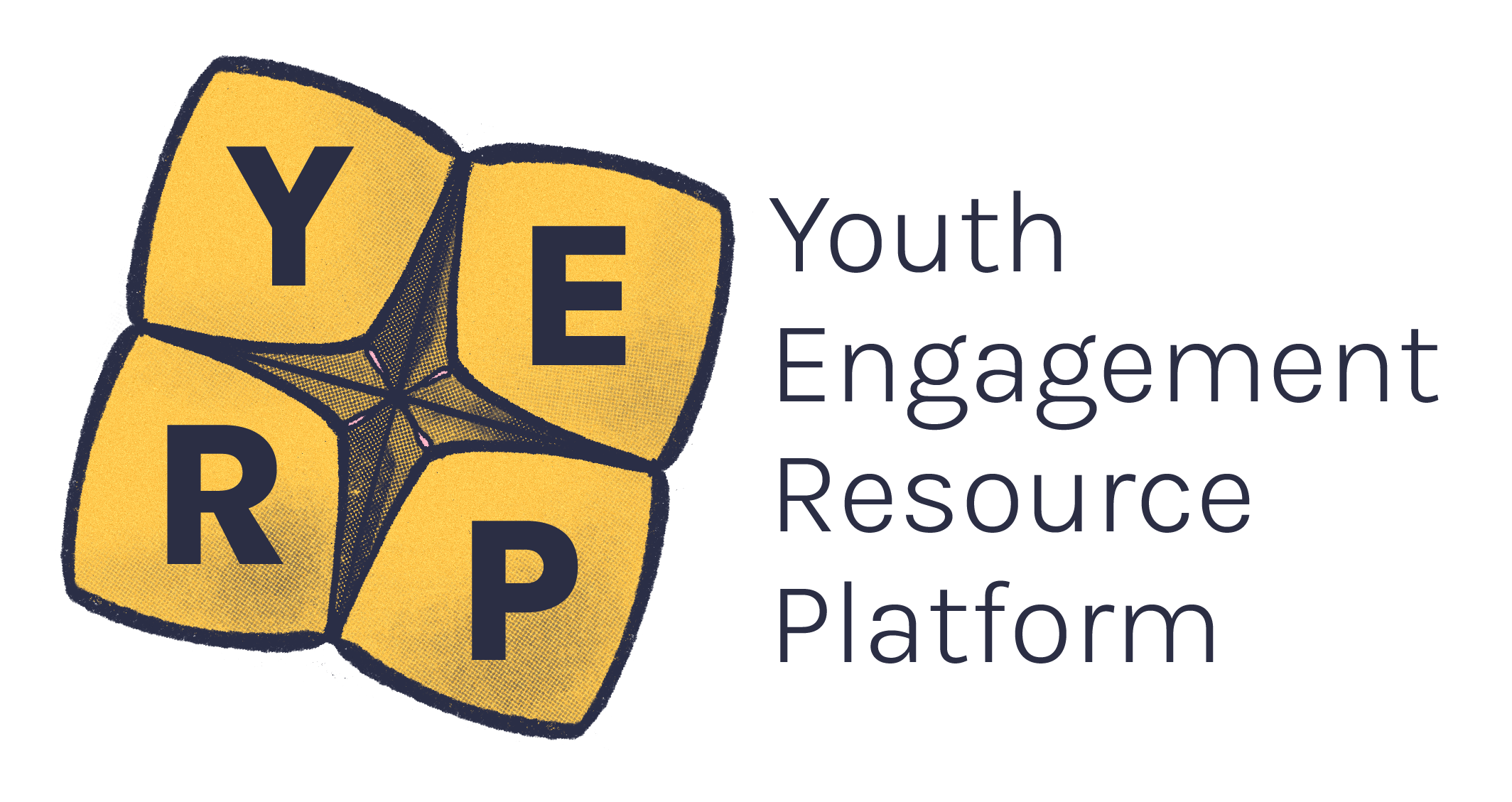Put simply, consent is giving permission for something to happen.
Consent can be given in any way that is accessible for the person, but it’s A way of doing something that is considered the most ethical and effective.best practice to use a written consent form that is signed and that can be kept on file.
The environments in which youth workers and young people work together can vary enormously. You should take care to make giving consent relevant and accessible for every young person.
To be valid, consent needs to be informed, freely given or voluntary, specific and current.
Informed consent
Being informed means a person has received all the necessary information, and understands it, before they make a decision. They understand the situation and the benefits and/or consequences of taking part.1, 2
Voluntary consent
When consent is freely given or voluntary, it means the person has made the choice to engage or to not engage all on their own. They have not been influenced by other people or other pressures.2
Specific consent
Specific means the consent applies only for the information to be used for the purpose outlined or to do one activity rather than multiple.2
Current consent
Current means the consent should have been received in a timely manner, not so long ago that relevant circumstances or the person’s view may reasonably have changed.2
Close-up of a youth worker's hands holding sticky notes with examples of how to ask for consent. They read:
- Would you like to?
- Is this something you would like to do?
- Not this time
- Nope.
- Ghost them.
- That sounds OK.
- Sure.
- Send a text asking.
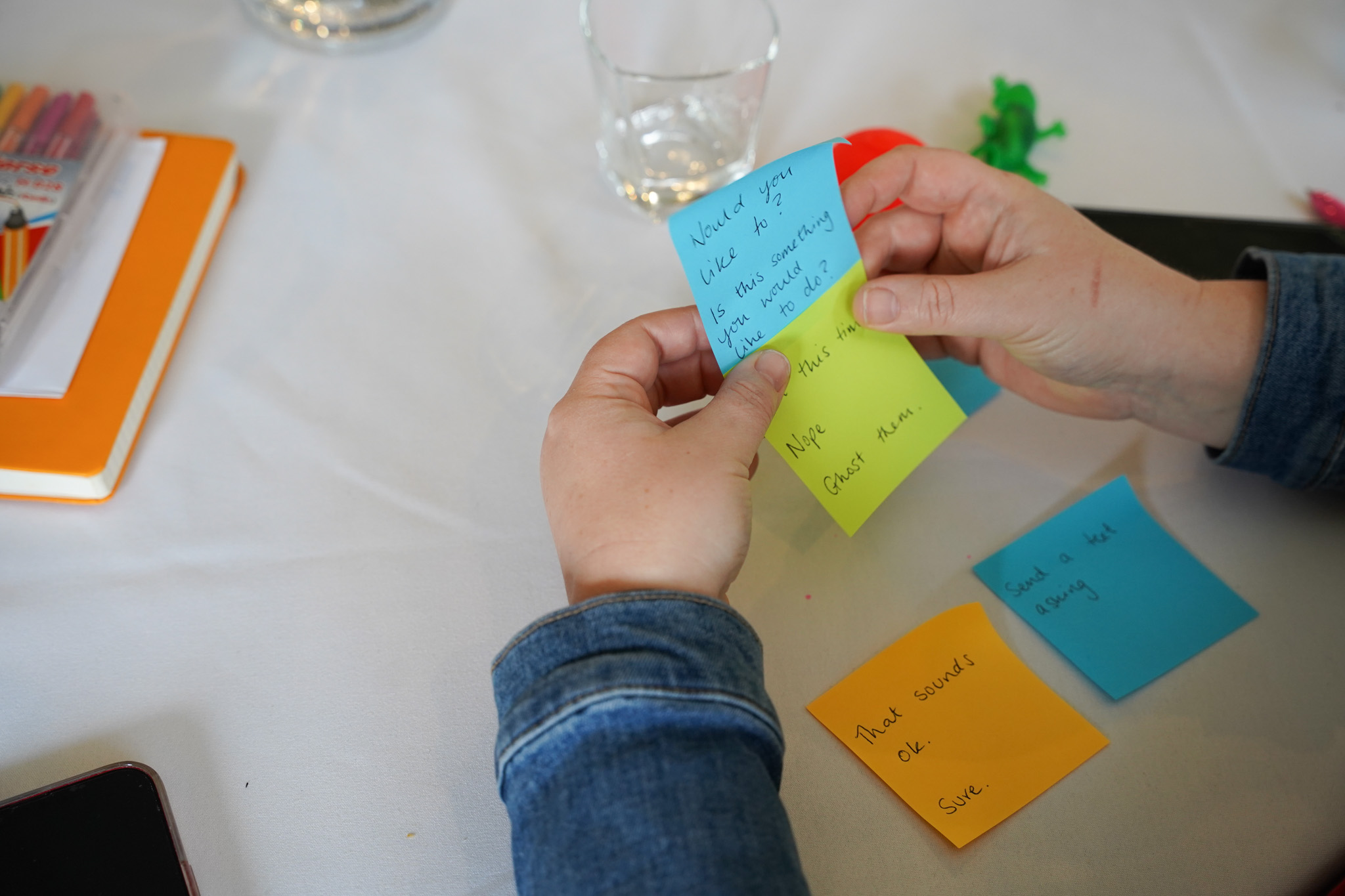
Depending on the context or situation you are dealing with, there may be an age of consent. We recommend reading relevant legislation in this area.
Some examples of when you should get consent from the young people you work with are:
- Before taking their image whether that is a photograph, video or voice recording and again if you want to use that image in a newsletter or report. Consent should be given to A) take the photo, and B) use the photo at that time. If the photo is used at a later time, consent should be sought again.3, 4
- If you need to use or exchange their private information.
- Before taking them on an excursion.
- Before their involvement in a consultation or focus group.
- Before using their artwork or words.
- Before being interviewed by media.
We often hear consent talked about in terms of sexual relationships, and you might sometimes need to talk to young people about this. You can refer to the federal government released the Commonwealth Consent Policy Framework to “support any organisation working to prevent sexual violence, to promote healthy sexual relationships and sexual consent to young people.”
Two young people looking over a laptop.

Young people can withdraw their consent at any time, and multiple times if necessary.5
Even if they give consent, they can ‘take it back’.
If a young person withdraws their consent, an organisation or agency can’t rely on the young person’s past consent for any future use or disclosure of personal information.5
You should always gain parental/guardian consent for children aged under 16.
For young people aged 16 and 17, you should decide whether parental/guardian consent is necessary depending on the activity and the young person’s individual circumstances.
If you decide parental/guardian consent isn’t needed, you should still consider whether they need to be informed that their child is taking part. In most circumstances, parents have a legal parental responsibility for their children up to the age of 18.
You may need to get parental/guardian consent if the young person does not fully understand what you are explaining in regards to what they are consenting to and the potential consequences of giving their consent. For example, not fully understanding the risks of doing a live TV interview and the potential to be trolled on their social media.
In this case, it’s good practice to gain the parent or guardian’s consent in addition to the young person’s consent. This way the young person has support but is still actively involved in the decision about whether or not to take part.5
Please note that consent from children and young people is not a replacement for parental consent. It’s a way to empower them, and for the child or young person to be involved in the decision-making process.
Getting consent is about making the young person feel empowered, centring them and their needs and wants.
Regardless of whether a parent or guardian has given their consent, always remember to ask the young person and find out whether they really want to be involved in an event, program or activity.
Being a ‘mature minor’ is when a young person under the age of 18 is capable of understanding their actions and can make decisions on their own.
Consider what information young people may not want to share with others. It can be a good idea to have an option for young people to share information on what they don’t want you to share (i.e., what you should keep confidential).
This ensures everyone is clear on the young person’s expectations and consent.
See below for an example of when a young person may not want all their information shared with their parents.
Text reads:
You have shared personal information with us. Please tick what you are happy for us to share with others:
- My birth name
- My chosen name
- My pronouns
- My date of birth
- My email
- My phone number
- Details about where I live
- Details about my religion
- Other (please specify)_______
Anything you do not tick will remain confidential.
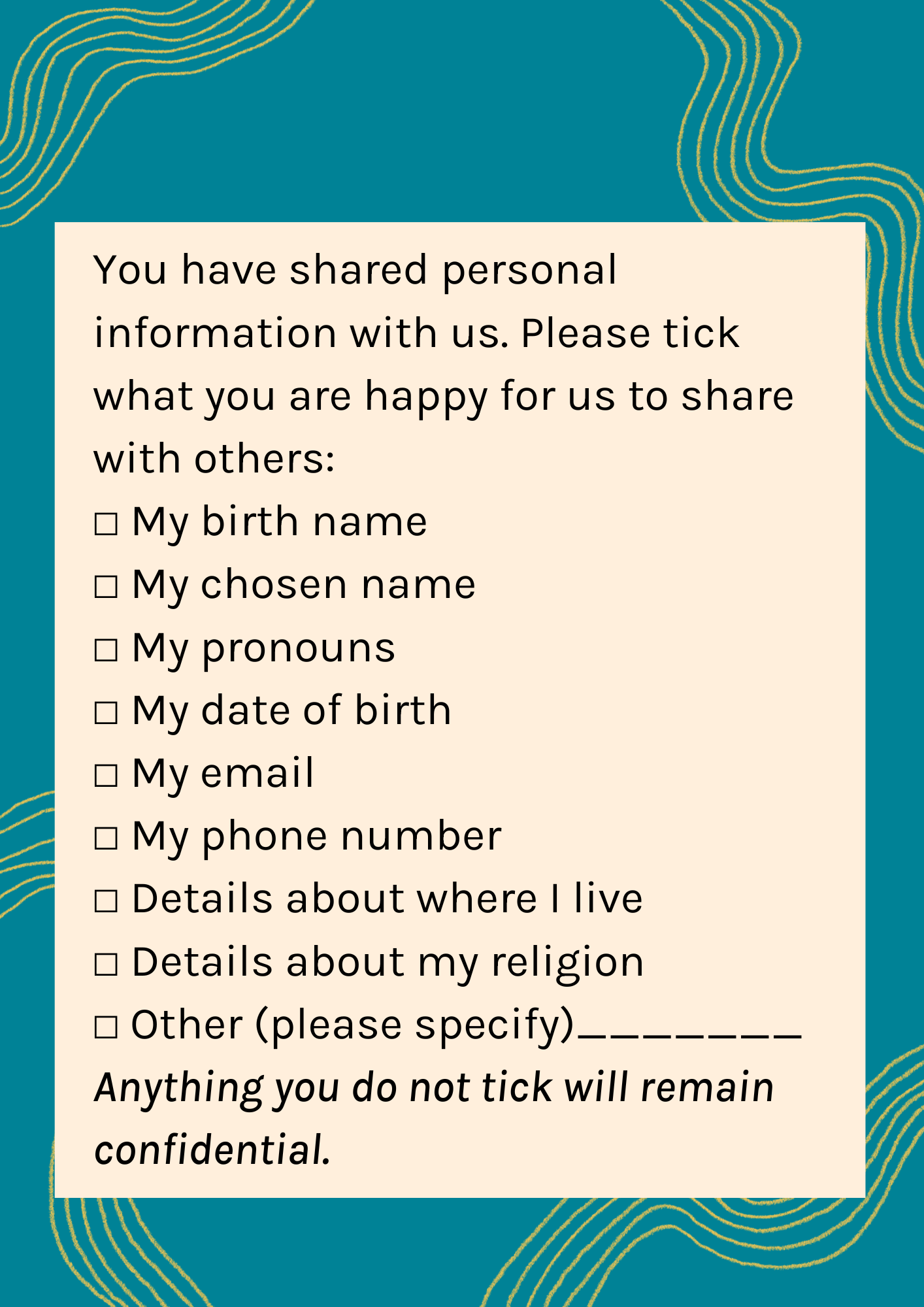
You are running a roundtable focusing on trans and gender diverse experiences in health settings. A young person wants to participate, however as they are under 18, according to your organisation’s policy they will need parental consent to join.
This is tricky because the young person has not ‘come out’ to their parents yet. They use a different name and pronouns at home than they do when they’re working with you.
- Start with making the roundtable safer to participate in - public information about it should be general enough to keep the young person safe. For example, you could advertise it as a roundtable about ‘gendered experiences of health’, not ‘trans and gender-diverse experiences of health’.
- Ask the young person if there’s a different name or pronouns you should use for them in different situations. Find out which name and pronouns that young person wants you to use when talking to their parents for consent.
- You might like to keep a confidential database that records the following information for all participants:
- Name
- Pronouns
- Any preferences about name and pronouns in different settings
- Whether they are comfortable sharing their pronouns and name with their parents/guardians. If they aren’t, note how they would like you to refer to them when communicating with parents/guardians.
You are running a social event for LGBTIQA+ young people. There are lots of flags and rainbow decorations celebrating queer pride, and everyone at the event is enjoying being themselves. Everyone is wearing name tags with their pronouns.
You have the consent of everyone to take photos. With the success of the event, you would love to share a few photos on your organisation’s public Instagram.
- Remember, consent to take a photo does not mean consent to use that photo anywhere, any time. For every photo you want to share, check with every person. Be specific about when you will share it, and on what platform.
- Have appropriate photo consent forms - see our tips and template below.
- Do not tag people in the photos.
While the concept of consent is simple, the identities of young people are complex. For young people in the LGBTIQA+ community, you will need to navigate the ethics of consent with the complexities of ‘coming out’, without outing them to parents or others
Accessibility should be considered for anyone when seeking consent, especially to uphold consent being informed, voluntary, specific and current.
People have differing accessibility needs, so consider having multiple options for people to give their consent. As long as the necessary information is provided, in most cases consent can be given in various ways, including:
-
Filling out a consent form
-
Written consent via email
-
Mailing a letter or form
-
Voice recording/video recording
-
Calling and giving consent over the phone.2
It’s always best to write consent forms with access in mind, using plain English (or A style of presenting written information for people with low English literacy. It is usually used for people with intellectual disabilities, and/or who speak English as a second language.Easy English if necessary). It’s easier to understand and often quicker to read and write.
Our tips for plain English consent forms:
- Keep your objectives and key messages clear
- Consider your audience and their needs
- Organise your information in a logical flow and order
- Use clear headings
- Use short, simple words and sentences
- Use everyday language
- Use examples
- Use a consistent tense
Check out Voice at the Table’s Tips for Easy English and Scope’s training and resources.
♫ Upbeat instrumental music plays in background ♫
Sam: Do I have to?
Young person: It's just a prick
Sam: [Ahhh] All right.
Doctor: Sam?
Sam: Wish me luck
Doctor: Have a seat
[door closes and locks]
Doctor: Sam, what do we have you in for today?
Sam: Just the flu shot
Doctor: Okay, [um], have you had any flu shots before?
Sam: No, I just kind of hate needles
Doctor: Well, then we'll just have a few questions for you before we get started.
Have you had any vaccinations in the last 6 months?
Sam: No
Doctor: Okay are you pregnant or do you have any pre-existing medical conditions?
Sam: No, but I do have asthma
Doctor: All right, and [um], okay everything looks fine here so do you have any questions for me before we get started?
Sam: No
Doctor: Okay, right or left arm?
Sam: Right
Doctor: All right that's it, you did a great job... there you go.
Sam: [Um] Okay, is there anything else I need to do?
Doctor: Well, it's entirely optional but in conjunction with the company that's producing the flu shot, you can choose to do some follow up check ups that just see if you've had any issues with the drug.
or what your experience it with us been in general.
Sam: Will it be anonymous?
Doctor: Not necessarily but, we can record you under a pseudonym if you prefer that.
Sam: Yes please, I don't want my details recorded with the information I provide.
Doctor: But otherwise you're happy to participate in the follow up sessions?
Just to see how your experience has been?
Sam: Yes, I'd like to participate
Doctor: Alright wonderful, so what you would like your pseudonym to be recorded down as?
Sam: I don't really mind, John Appleseed of something... the typical
Doctor: Got it, here I just need you to sign this as confirmation that you consent to your information and feedback being shared.
Granted, your name will not be shared, but still your medical information.
Sam: Oh okay, I do give consent for the feedback I give to be shared.
[Sam signs the consent form, sound of pencil writing on paper]
Sam: Alright, I'm done.
Doctor: Alright, thank you for that.
You should be all good to go, just wait outside for 15 or so minutes so we can make sure you are okay.
If you experience any nausea, headaches, fever, vomiting, let us know.
But otherwise, you'll be good to go.
Sam: Thank you
Doctor: Thank you
♫ Upbeat instrumental music plays in background ♫
Sam: She said to wait here for 15 minutes in case I felt sick
Young person: Good, do you feel okay?
Sam: Yeah, I'm feeling sleepy, I want to go home
Young person: We can go home
Sam: Yeah we can?
Young person: Yeah if you feel like it, we can go home.
Sam: Okay, let's go home.
Young person: Would you like a hug?
Sam: No, my arm hurts
Young person: That's okay, we can just go home
Sam: Yeah, let's go home
♫ Upbeat instrumental music plays in background and fades out♫
In this video, a young person goes to get a needle at the doctor. See how many types of consent you can identify in this situation.
- what you’re seeking consent for
- the name and signature of the person/s giving consent
- date of signature
- contact details of the person.6
If the person is under 16, they will need parental consent, so include a section for this as well.
Consider the below example. You can use it to make your own Consent Form that reflects the child safeguarding needs of the children and young people your organisation works with. The form should align with your organisation’s other child safeguarding policies, procedures and practices.
If you’re working with young people, you have ethical responsibilities and legal obligations, including a duty of care to protect a young person’s privacy and confidentiality.
Privacy laws
There are several laws that control how businesses, government-funded or community sector organisations can collect, use and keep personal and health information:
- In Victoria, you have privacy rights under the Privacy and Data Protection Act 2014 (Vic) (PDP Act)
- In Victoria, you have the Health Records Act 2001 (the Act) to protect the privacy of individuals' health information.
These laws help you to understand and respect young people’s privacy, and plan how you will go about collecting and storing information.
Types of private information
There are different types of private information.
Personal information includes a broad range of information, or an opinion, that could identify an individual.
For example, personal information may include:
- an individual’s name, signature, address, phone number or date of birth
- financial information6, 7
- photographs3, 4
- location information from a mobile device (because it can reveal user activity patterns and habits).
Sensitive information
This is personal information that includes information or an opinion about an individual’s:
- racial or ethnic origin
- political opinions or associations
- religious or philosophical beliefs
- trade union membership or associations
- sexual orientation or practices
- criminal record
- health-related information.5
Storing information
When handling personal or sensitive information, be sure to store it in a secure and confidential way.8
Consider the following:
- explain where their material such as a photograph, video, voice recording, artwork etc will be stored, and for how long it will be kept on file and used publicly. It is considered best practice to only use materials for five years. Images should never be taken on personal devices.
- if the information is kept digitally, make sure it is password protected using two-factor authentication where possible.
- remove a person’s identity from the information as soon as possible.
- secure backup of digital information.8
If you are unsure how long you should retain personal information, check out the resources on Public Record Office Victoria for advice.
Three young people chatting and looking over a laptop screen.

- Australian Commission on Safety and Quality in Healthcare. (2023). Informed Consent. https://www.safetyandquality.gov.au/our-work/partnering-consumers/informed-consent
- Information and privacy commission. (2023). Fact Sheet. https://www.ipc.nsw.gov.au/fact-sheet-consent
- Australian Institute of family studies. (April 2015). Images of children and young people. https://aifs.gov.au/resources/resource-sheets/images-children-and-young-people-online
- eSafety Commissioner. (17 December 2023). Consent for sharing photos and videos.https://www.esafety.gov.au/young-people/consent-sharing-photos-videos
- Office of the Australian Information Commissioner. (2023). Consent to the handling of personal information. https://www.oaic.gov.au/privacy/your-privacy-rights/your-personal-information/consent-to-the-handling-of-personal-information
- Youth Law. (2012). What do I do when? https://youthlaw.asn.au/wp-content/uploads/2012/08/What-Do-I-Do-When_2012.pdf
- Office of the Australian Information Commissioner. (2023). What is personal information? https://www.oaic.gov.au/privacy/your-privacy-rights/your-personal-information/what-is-personal-information
- Public Record Office Victoria. (2023). Privacy and recordkeeping obligations. https://prov.vic.gov.au/recordkeeping-government/a-z-topics/privacy-and-recordkeeping-obligations
Related Topics
Note: This resource is a broad consideration of consent when working with young people. It’s in no way prescriptive to legal considerations, and we recommend you seek legal advice if you need it. If not in place already, ask your organisation to put in place clear consent processes and develop easy-to-use templates.
